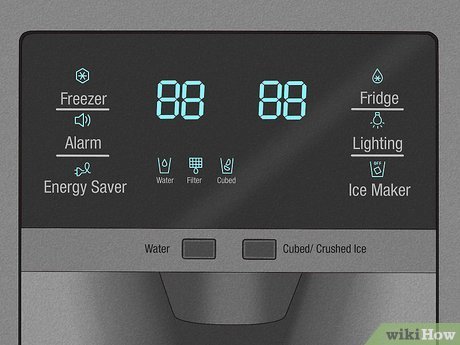
Imagine your fridge as a complex puzzle, with each part serving a unique purpose to keep your groceries fresh and your ice cream perfectly frozen. The error code “LE” is like a missing puzzle piece; with it in place, everything runs smoothly. Without it, the chaos of a warm fridge ensues. Let’s dive into the why and how of this error code, unraveling the mystery and helping you get your appliance back on track, without the need for a costly technician visit.
Understanding the Error Code “LE”
The “LE” error code is your refrigerator’s way of saying there’s a *hiccup* in communication. This situation usually arises when there’s a glitch between the ice maker and the main control board. Think of it as two friends who’ve suddenly lost cell service while coordinating a party. Without proper communication, the ice maker can’t function as it should, leading to this pesky error code popping up on your fridge display.
When this code appears, it’s usually due to an issue with the water inlet valve, which supplies water to the ice maker. Imagine turning on a tap and nothing comes out – the same principle applies here. The valve might be blocked or malfunctioning, disrupting the supply and resulting in this error. Another possible cause could be a disruption in the electrical connection between the components, similar to a loose plug causing a lamp to flicker.
The good news is that identifying these problems is the first step toward solving them. By checking a few connections or resetting certain components, you can often resolve the issue quickly. It’s all about playing detective with your fridge, understanding the signals, and taking the right action to ensure smooth sailing in your kitchen.
Steps to Reset Your Samsung Refrigerator
You’ve seen the code and have an idea of the issue – now what? It’s time to roll up your sleeves and do a reset. Don’t worry; it might sound technical, but resetting your fridge is akin to rebooting your smartphone when it freezes. That simple restart often clears up temporary bugs and helps systems run smoothly again. Here’s how to do it:
First, unplug your refrigerator. This is like giving your fridge a short nap, letting it rest and reset its internal systems. Leave it unplugged for about 5 to 10 minutes, providing enough downtime for the internal computers to reset. Then, plug it back in, which effectively reboots the system, just like powering your phone back on.
Next, check the ice maker itself. Sometimes, it’s as easy as turning off the ice maker, waiting a moment, and then turning it back on. This process is similar to toggling a light switch off and on to reset it. You’re essentially giving the computer that runs the ice maker another chance to start fresh and communicate properly with the main board.
Finally, consider performing a full reset from the control panel on your fridge, if available. Look for a reset button, often found in or near the ice maker settings, and hold it down for a few seconds. This step acts as a manual override, telling your refrigerator to start fresh and clear any leftover errors.
Dealing With Persistent Issues
So, you’ve tried resetting the fridge, but the “LE” code won’t leave you alone. It can be frustrating, like when a mosquito just won’t stop buzzing around. In this case, you might need to delve a bit deeper or consult a professional for assistance.
One thing to inspect is the water filter. If it’s clogged or out of date, it could impact the water flow, much like a kinked hose preventing water from reaching your garden. Replacing or cleaning the filter might be the key to solving the problem. Make sure the water lines are clear too, as blockages here can also trigger error codes.
Additionally, take a closer look at the wiring connections. Loose or corroded wires could disrupt communication between the components, much like static on a phone line making it hard to hear the other person. Tighten any loose connections and clean off any visible corrosion to improve functionality.
If all else fails, you may need a technician’s expertise. Sometimes, internal parts, like the control board or sensors, may need professional attention or replacement. It’s a bit like when your car’s check engine light comes on, and you need a mechanic to diagnose the trickier problems under the hood.
Preventing Future “LE” Code Errors
Prevention is always better than cure, right? A few careful maintenance steps can keep that “LE” error at bay, saving you from future headaches. Think of it like regular oil changes for your car – a bit of consistent care to keep everything humming along smoothly.
Regularly cleaning and replacing the water filter is crucial. Imagine trying to drink through a clogged straw – not fun, and your fridge thinks so too. Checking it every few months ensures a clean flow of water, preventing blockages that could lead to error codes.
Keep an eye on the ice maker and surrounding area. Debris, ice buildup, or obstructions can impede performance, much like leaves clogging a gutter. A quick check and clean every now and then can help everything function perfectly, reducing the chance of errors popping up.
Lastly, schedule periodic maintenance checks. Whether you do it yourself with tips from your fridge’s manual or hire a professional, regular check-ups can catch potential issues before they turn into “LE” headaches. It’s like visiting the dentist – small check-ups now can prevent major work later on.
With these tips and steps in your back pocket, the “LE” error on your Samsung refrigerator should be less daunting. Regular maintenance, understanding how to reset the system, and knowing when to call for help can keep your fridge running smoothly, ensuring it stays a reliable part of your kitchen for years to come.